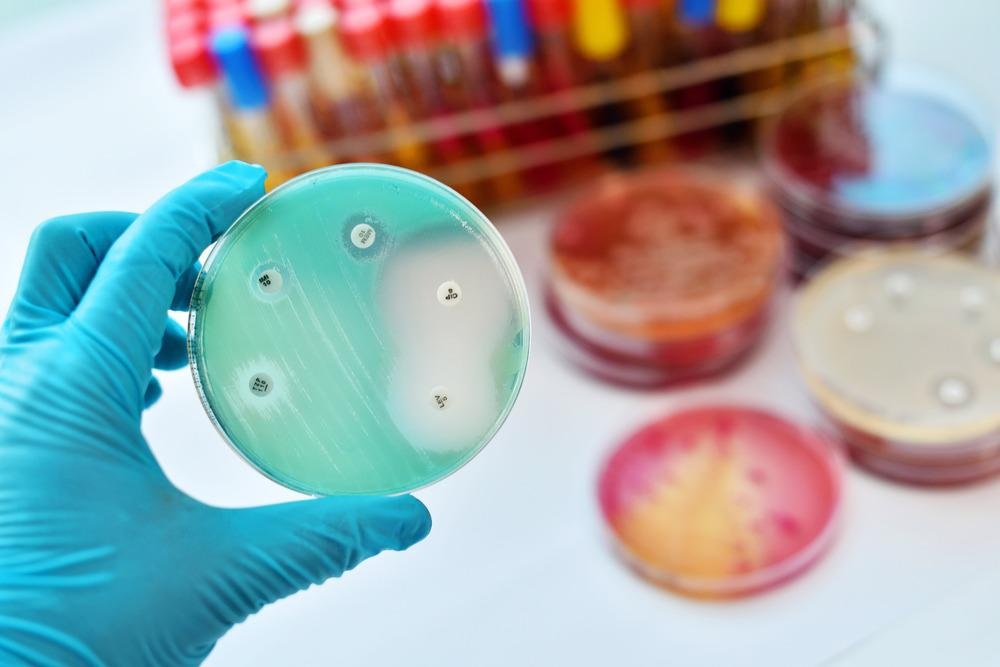An article published in the journal Carbohydrate Polymers presented a novel approach of utilizing nanogels for antibacterial fabric. Due to the recent upsurge of drug-resistant infections, it has become increasingly important to utilize potent antimicrobial agents.

Study: Preparation of quaternized chitosan/Ag composite nanogels in inverse miniemulsions for durable and antimicrobial cotton fabrics. Image Credit: Jarun Ontakrai/Shutterstock.com
Nanoparticles are at the forefront of scientific research and development, and some exhibit properties which render them an effective tool in combatting such pathogens. Embedding these materials in items of daily use such as fabric can allow for continuous protection against such pathogens.
Bacteria on the Rise
Pathogenic bacteria are the greatest cause of mortality worldwide, with many diseases humans caused by microbe-infested surfaces. For a long time, antibiotics have dominated treatment techniques for bacterial infections and continue to do so. Despite significant improvements, antibiotic overuse has led to a dramatic surge of drug-resistant bacteria in recent decades, resulting in widespread disease and death.
To address this problem, one method is to improve antibiotic bioavailability while concurrently reducing the prescribed dose. Developing antimicrobial agents to treat bacterial illnesses effectively and reliably is therefore crucial.
How can Nanotechnology Help?
Recent advancements in nanotechnology present an alternate tactic in the fight against bacterial diseases owing to the specific chemical and physical characteristics of different nanoparticles.
Thanks to their larger surface area, changeable size of particles, and wide-ranging antimicrobial features against drug-resistant bacteria, silver nanoparticles (Ag NPs) have seen extensive use in medical tools and pharmaceutical items.
Although silver ions are generally considered to be harmless for human cells and tissues, when analyzed on the nanoscale, there is growing concern regarding the toxicity of silver nanoparticles. The buildup of these nanoparticles in human organs and tissues may have harmful outcomes such as cell death or DNA damage. Moreover, silver NPs can be susceptible to oxidation which renders their long-term antibacterial impact insufficient.
These issues can be solved via the encapsulation of silver nanoparticles in a carrier, which is an effective strategy for achieving stability and long-lasting antimicrobial potency.
As a mild natural substance, chitosan (CS) demonstrates exceptional biocompatibility and biodegradability. However, its low solubility in water and mediocre antibacterial characteristics hampers its antibacterial uses, particularly in complicated antimicrobial systems. On the other hand, Quaternized chitosan (QCS), having constant positive ionic charges on the backbone, is soluble in water at elevated pH values and shows good antimicrobial capacity.
Many attempts have been made to create QCS/Ag NPs nanocomposites because of the antibacterial superiority offered by the synergized action of QCS and Ag NPs.
However, previous methods could not produce desired controllability and flexibility, resulting in low encapsulation efficiency or unmanageable loaded content of silver nanoparticles. Therefore, the importance of an efficient method of producing QCS/Ag composite nanogels (CNGs) with desired controllability and flexibility is critical.
Inverse Miniemulsions for Preparing QCS/Ag CNGs
The study found that the inverse miniemulsion technique effectively creates QCS/Ag composite nanogels. The silver nanoparticles may be pre-loaded in the polar dispersion phase containing reactive materials.
In the continuous organic phase, nanoscale droplets are formed and stabilized by emulsification. Using the droplet nucleation method, each droplet may be seen as a nano-reactor, providing excellent encapsulation efficiency and adjustable loading of silver nanoparticles. Hence the inverse miniemulsion method trumps other heterogeneous approaches like inverse emulsion and microemulsion.
The developed QCS/Ag CNGs fused the special characteristics of QCS and silver nanoparticles, exhibiting effective antibacterial properties and minimal cytotoxicity. It is possible to chemically immobilize these composite nanogels on plasma-treated cotton textiles using a pad-dry-cure procedure that helps in retaining the antibacterial effects even after washing.
Properties of the Nanogel-Integrated Fabric
The silver composite nanogels developed in the study demonstrated impressive broad-spectrum antibacterial capability. Controlling the degree of cross-linkage and the QCS/Ag CNGs' dose allows the antibacterial effectiveness to be tuned as per requirements.
The growth of C. albicans, E. coli, and S. aureus was significantly suppressed under the optimum degree of cross-linkage. The high antibacterial efficacy shown by the silver composite nanogels, particularly against C. albicans (fungi), makes them suited for a wide range of antimicrobial purposes.
Incorporating antimicrobial properties in pure cotton textiles does not remove their essential qualities of water vapor absorption and permeability, elasticity, and tensile strength.
Researchers also found that the thermal stability of the pure cotton fabrics was not compromised with the addition of the silver nanogel composites, and the final product displayed similar levels of whiteness to those of the pure textiles. The addition of silver composite nanogels added a layer of protection in cotton fabrics against microbial pathogens without compromising any comfort-related characteristics of the textile.
Continue reading: NANO-LLPO: Using Nanomaterials to Heal Wounds.
References
Gao, F., Mi, Y., Wu, X., et al., (2021) Preparation of quaternized chitosan/Ag composite nanogels in inverse miniemulsions for durable and antimicrobial cotton fabrics. Carbohydrate Polymers. Available at: https://doi.org/10.1016/j.carbpol.2021.118935
Disclaimer: The views expressed here are those of the author expressed in their private capacity and do not necessarily represent the views of AZoM.com Limited T/A AZoNetwork the owner and operator of this website. This disclaimer forms part of the Terms and conditions of use of this website.